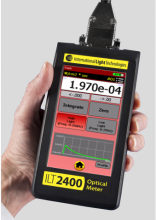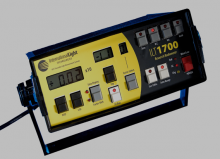Choosing a Radiometer (Chapter 13)
Detectors translate light energy into an electrical current. Light striking a silicon photodiode causes a charge to build up between the internal "P" and "N" layers. When an external circuit is connected to the cell, an electrical current is produced. This current is linear with respect to incident light over a 10 decade dynamic range.
A wide dynamic range is a prerequisite for most applications. The radiometer should be able to cover the entire dynamic range of any detector that will be plugged into it. This usually means that the instrument should be able to cover at least 7 decades of dynamic range with minimal linearity errors. The current or voltage measurement device should be the least significant source of error in the system.
The second thing to consider when choosing a radiometer is the type of features offered. Ambient zeroing, integration ability, and a “hold” button should be standard. The ability to multiplex several detectors to a single radiometer or control the instrument remotely may also be desired for certain applications. Synchronous detection capability may be required for low level signals. Lastly, portability and battery life may be an issue for measurements made in the field.



Floating Current to Current Amplification
ILT radiometers amplify current using a floating current to-current amplifier (FCCA), which mirrors and boosts the input current directly while “floating” completely isolated.
The FCCA current amplifier covers an extremely large dynamic range without changing gain. This proprietary amplification technique is the key to our unique analog to digital conversion, which would be impossible without linear current preamplification.
We use continuous wave integration to integrate (or sum) the incoming amplified current as a charge, in a capacitor. When the charge in the capacitor reaches a threshold, a charge packet is released. This is analogous to releasing a drop from an eye dropper. Since each drop is an identical known volume, we can determine the total volume by counting the total number of drops. The microprocessor simply counts the number of charge packets that are released every 500 milliseconds. Since the clock speed of the computer is much faster than the release of charge packets, it can measure as many as 5 million, or as few as 1 charge packet, each 1/2 second. On the very low end, we use a rolling average to enhance the resolution by a factor of 4, averaging over a 2 second period. The instrument can cover 6 full decades without any physical gain change!
In order to boost the dynamic range even further, we use a single gain change of 1024 to overlap two 6 decade ranges by three decades, producing a 10 decade dynamic range. This “range hysteresis” ensures that the user remains in the middle of one of the working ranges without the need to change gain. In addition, the two ranges are locked together at a single point, providing a step free transition between ranges. Even at a high signal level, the instrument is still sensitive to the smallest charge packet, for a resolution of 21 bits within each range! With the 10 bit gain change, we overlap two 21 bit ranges to achieve a 32 bit Analog to Digital conversion, yielding valid current measurements from a resolution of 100 femtoamps (10-13 A) to 2.0 milliamps (10-3 A). The linearity of the instrument over its entire dynamic range is guaranteed, since it is dependent only on the microprocessor's ability to keep track of time and count, both of which it does very well.
Transimpedance Amplification

Transimpedance amplification is the most common type of signal amplification, where an op-amp and feedback resistor are employed to amplify an instantaneous current.
Transimpedance amplifiers are excellent for measuring within a fixed decade range, but must change gain by switching feedback resistors in order to handle higher or lower signal levels. This gain change introduces significant errors between ranges, and precludes the instrument from measuring continuous exposures.
A graduated cylinder is a good analogy for describing some of the limitations of transimpedance amplification. The graduations on the side of the cylinder are the equivalent of bit depth in an A-D converter. The more graduating lines, the greater the resolution in the measurement. A beaker cannot measure volumes greater than itself, and lacks the resolution for smaller measurements. You must switch to a different size container to expand the measurement range - the equivalent of changing gain in an amplifier.
In a simple light meter, incoming light induces a voltage, which is amplified and converted to digital using an analog-to -digital converter. A 10 bit A-D converter provides a total of 1024 graduations between 0 and 1 volt, allowing you to measure between 100 and 1000 to an accuracy of 3 significant digits. To measure between 10 and 100, however, you must boost the gain bya factor of 10, because the resolution of the answer is only two digits. Similarly, to measure between 1 and 10 you must boost the gain by a factor of 100 to get three digit resolution again. In transimpedance systems, the 100% points for each range have tobe adjusted and set to an absolute standard. It is expected for a mismatch to occur between the 10% point of one range and the 100% point of the range below it. Any nonlinearity or zero offset error is magnified at this 10% point.
Additionally, since voltage is sampled instantaneously, it suffers from a lower S/N ratio than an integrating amplifier. Transimpedance amplifiers simulate integration by taking multiple samples and calculating the average reading. This technique is sufficient if the sampling rate is at least double the frequency of the measured signal.
Integration
The ability to sum all of the incident light over a period of time is a very desirable feature. Photographic film is a good example of a simple integration. The image on the emulsion becomes more intense the longer the exposure time. An integrating radiometer sums the irradiance it measures continuously, providing an accurate measure of the total exposure despite possible changes in the actual irradiance level.
The primary difficulty most radiometers have with integration is range changes. Any gain changes in the amplification circuitry mean a potential loss of data. For applications with relatively constant irradiance, this is not a concern. In flash integration, however, the change in irradiance is dramatic and requires specialized amplification circuitry for an accurate reading.
Flash integration is preferable to measuring the peak irradiance, because the duration of a flash is as important as its peak. In addition, since the total power from a flash is low, an integration of 10 flashes or more will significantly improve the signal to noise ratio and give an accurate average flash. Since International Light radiometers can cover a large dynamic range (6 decades or more) without changing gain, the instruments can accurately subtract a continuous low level ambient signal while catching an instantaneous flash without saturating the detector.
The greatest benefit of integration is that it cancels out noise. Both the signal and the noise vary at any instant in time, although they are presumably constant in the average. International Light radiometers integrate even in signal mode, averaging over a 0.5 second sampling period to provide a significant improvement in signal to noise ratio.
Zero
The ability to subtract ambient light and noise from readings is a necessary feature for any radiometer. Even in the darkest room, electrical “dark current” in the photodiode must be subtracted. Most radiometers offer a “Zero” button that samples the ambient scatter and electrical noise, subtracting it from subsequent readings.
Integrated readings require ambient subtraction as well. In flash measurements especially, the total power of the DC ambient could be higher than the power from an actual flash. An integrated zero helps to overcome this signal to noise dilemma.

Request Light Management Handbook as PDF (ALL Chapters)
Chapter 13 - The Light Measurement Handbook
Copyright © 1997 by Alexander D. Ryer
All Rights Reserved.
No part of this publication may be reproduced or transmitted in any form or by any means, electronic or mechanical, including photocopying, recording, or any information storage and retrieval system, without permission in writing from the copyright owner. Requests should be made through the publisher.
Technical Publications Dept.
International Light Technologies
10 Technology Drive
Peabody, MA 01960
ISBN 0-9658356-9-3
Library of Congress Catalog Card Number: 97-93677
Explore more light measurement resources
